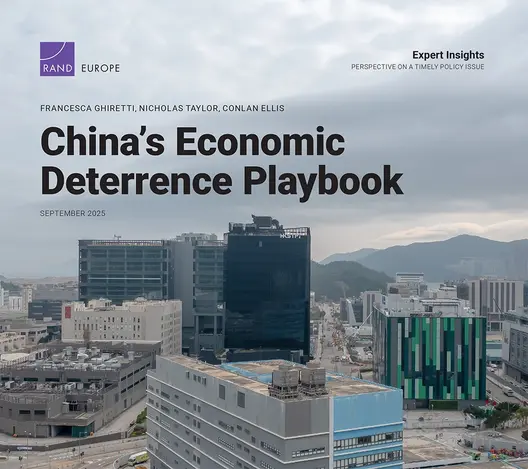
作者/Author(s): Francesca Ghiretti, Nicholas Taylor, and Conlan Ellis
網站來源/Source: RAND Corporation
日期/Date: 09/10/2025
關鍵字/Keywords: 經濟、中國、拒止性嚇阻
摘要:
隨著世界進入經濟戰時代,對中國的施壓手段似乎日益失效。本文不探討中國推動經濟脅迫或強化經濟安全工具的能力,而是聚焦於中國的經濟嚇阻能力——即中國如何防止他國對自身實施經濟脅迫。
拒止性嚇阻:提升關鍵投入與生產的韌性
- 拒止性嚇阻意指透過策略來阻止對手達成攻擊目標。在經濟領域,此策略涉及建立系統與措施,藉由最小化脆弱性、最大化韌性來遏止經濟脅迫與經濟戰。
- 中共始終強調經濟韌性的重要性,並持續強化經濟架構,以具備抵禦內外衝擊的能力。同時中國也積極推動資產與生產佈局多元化,從沿海城市轉向農村地區。
- 中國經濟韌性的關鍵要素包括:
- 優先發展與生存相關的戰略性產業。
- 雙循環戰略:在維持全球貿易體系聯繫的同時,盡可能在中國境內開發戰略物資。
- 當無法在國內生產優先戰略物資時,優先加強與供應國之間的聯繫。
- 學習如何生產戰略物資,並將所學技術轉移至本土製造。
- 確保國家長期支持經濟韌性建設承諾。
- 建立能整合關鍵產業的生態系統。
- 這些措施雖以提升「韌性」為核心,但若競爭對手發現中國經濟結構穩固、攻擊難以奏效,這些設施反而可以轉為「拒止性嚇阻」。然而,中國是否真的具有此種穩固韌性,仍待觀察。
- 中國的經濟韌性十足,在面臨內部挑戰的同時,仍是全球出口樞紐,亦在關鍵創新領域有所進展。
- 然而中國如今面臨更多新興的長期挑戰,暴露了自身經濟體系的弱點,並開始侵蝕中國在國際社會上的經濟聲譽。
Summary:
As the world enters an era of economic warfare, attempts to coerce China appear to be ineffective. Instead of examining China's capacity to advance economic coercion or strengthen its economic security instruments, this article focuses on China's economic deterrence—how China discourages others from employing economic coercion against itself.
Deterrence by denial: Improving resilience of critical inputs and productions
Deterrence by denial: Improving resilience of critical inputs and productions
- Deterrence by denial implies a strategy of dissuading an adversary from achieving its objectives through attack. In the economic sphere, it involves creating systems and measures that deter coercion and economic warfare by minimizing vulnerabilities and maximizing resilience.
- The CCP had always emphasized a focus on a resilient economy and strengthened it, making it resistant to internal and external shocks. China is also diversifying the location of its assets and production, moving from coastal cities to rural areas.
- The key elements in Chinese economic resilience are:
- Prioritize strategic sectors necessary for survival.
- Dual circulation strategy: Develop as many strategic goods as possible inside China while maintaining ties with the global trade system.
- When it could not produce prioritized strategic goods domestically, it fostered ties with countries that supply them.
- Learn to produce the strategic goods whenever possible and transfer the knowledge to Chinese production.
- Ensure state-backed commitment in building economic resilience.
- Create an ecosystem that integrates the priority sectors.
- The measures were more resilient-based, but could shift to economic deterrence by denial if the attacker knows that the target's economy is resilient and that its resilience will prevent attacks from achieving their objectives, which may not be the case for China.
- China is renowned for its resilient economy, serving as a global export hub, and progress in developing key innovations, despite internal challenges.
- However, China also faces new and long-term challenges, which have exposed the weaknesses of its economic system and started to erode its economic reputation.
